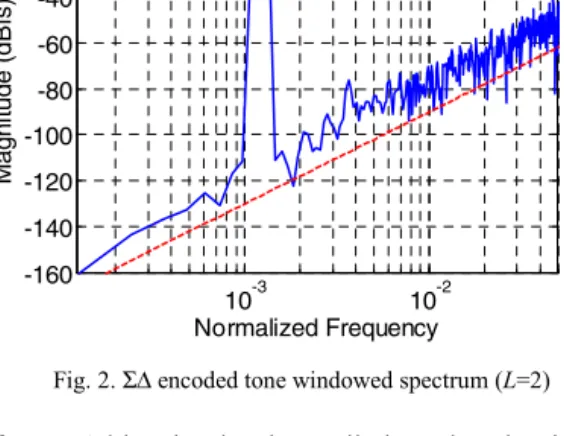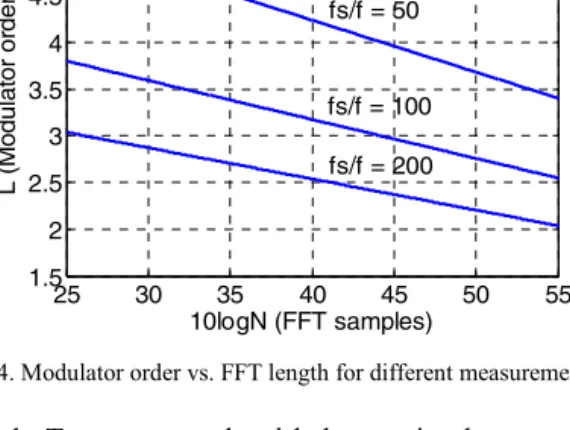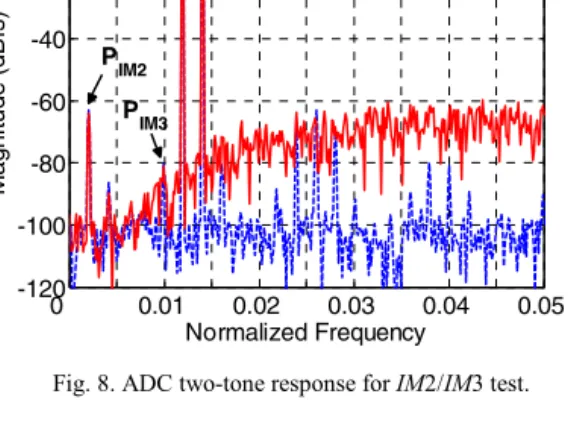On-chip Stimuli Generation
for ADC Dynamic Test by
ΣΔ Technique
Shakeel Ahmad and Jerzy Dąbrowski Department of Electrical Engineering
Linköping University 581 83 Linköping, Sweden e-mail: {shakeel, jdab}@isy.liu.se
Abstract—This paper presents application of the ΣΔ modulation
technique to the on-chip dynamic test for A/D converters. The wanted stimulus such as a single- or two-tone signal is encoded into one-bit ΣΔ sequence, which after simple low-pass filtering is
applied to the circuit under test with low noise and without distortion. In this way a large dynamic range is achieved making the performance harmonic- and intermodulation dynamic test viable. By a systematic approach we select the order and type of a
ΣΔ modulator, and develop the frequency plan suitable for
spectral measurements on a chip. The technique is illustrated by simulation of a practical ADC under test.
Keywords—Stimuli generation; on-chip test; ΣΔ modulation I. INTRODUCTION
With increased complexity of the contemporary ICs the mixed-signal test is becoming more cumbersome and costly. Production test techniques using test access points are often limited by chip performance, area overhead, and cost of the test instrumentation. For this reason design-for-testability (DfT) and built-in-self-test (BiST) techniques for mixed-signal ICs have been around for the last decade [1]. With the advent of embedded processors the mixed-signal/RF BiST on a chip has become viable. However, the practical implementations are still a challenge [2].
In this paper we address the on-chip stimuli generation, essential for BiST. The spectral purity and high SNR of the generated signals are the main objectives. Spectrally pure stimuli can be derived from 1-bit sequences using modulation techniques like PWM [3] or ΣΔ [4] implemented in software. In this case the D/A conversion can be achieved by simple low-pass filtering thus avoiding nonlinear distortions. In PWM approach the inherent high frequency components related to the PWM carrier frequency fc , can be suppressed effectively
with a passive analog filter. However, the associated quantization noise undergoes folding and the resulting FFT noise floor is proportional to fc/(Nfclk), where N is the FFT
length and fclk stands for the clock (sampling) frequency of the
system. A satisfactory noise floor level can be achieved at the expense of a large value of the product Nfclk since the carrier fc
must be (at least) by one order of magnitude larger than the frequency of the encoded signal, f0. Pushing fclk to practical
limits, say in a GHz range, might not be sufficient resulting in long FFT sequences that claim more test time.
To alleviate the problem the noise shaping technique based on ΣΔ modulation can be used as proposed in [4]. The quantization noise floor is largely reduced in this way providing a large dynamic range for spectral measurements. Here, we investigate different variants of the ΣΔ modulation in terms of the dynamic test especially for high performance A/D converters. For this purpose we specify the frequency measurement bands, and by a systematic approach choose the stimuli frequencies and select the order and type of a ΣΔ modulator suitable for spectral measurements. The harmonic- and intermodulation distortion measurements (HD# and IM#) are the primary concern in this case. By careful frequency planning a possible masking of spurious tones in the test response is avoided. We show that with a reasonable overhead, i.e. using moderate values of N and fclk, high dynamic range
measurements are viable. The method is validated by simulation of a practical ADC under test where the limitations due the ADC quantization effects are revealed. Especially the frequency selective measurements using band-pass ΣΔ-encoded stimuli are limited in this way.
II. STIMULI ENCODING AND DYNAMIC RANGE Consider a 1-bit signal from a low-pass ΣΔ modulator. If it is software generated its whole noise is the quantization noise. For the generic model of L-th order modulator the discrete noise transfer function is given by [5]:
( )
z Lz
NTF( )= 1− −1 (1)
Consequently, the power spectral density of the quantization noise can be estimated from:
(
)
( ) )(f NTFe 2 / 2S f
Sq = j πf fS n (2)
where )Sn(f)=Δ2/(12fS is assumed constant over the
Nyquist band, Δ is the quantizer resolution and fS is the
sampling (or clock) frequency. When using FFT with spectral
resolution Δf the resulting noise floor can be expressed as:
10-3 10-2 -160 -140 -120 -100 -80 -60 -40 -20 0 Magni tude (dB fs ) Normalized Frequency Fig. 1. ΣΔ encoded tone spectrum (L=2)
∫
Δ + Δ − = 2 / 2 / ) ( ) ( f f f f q q f S f df P (3)For large oversampling ratios the noise floor (3) can be calculated as: L S q f f N f P 2 2 2 12 ) ( ⎟⎟ ⎠ ⎞ ⎜⎜ ⎝ ⎛ Δ ≅ π (4)
where N is the FFT length and Δf = fS /N is the spectral
resolution. As seen, the noise floor is mostly affected by the oversampling ratio and the modulator order.
For the purpose of spectral measurements we can define the
dynamic range DR(f) using –3 dB FS ΣΔ-encoded tone with
amplitude Δ/(2√2) (to avoid overloading):
L S f f N f DR 2 2 4 3 ) ( ⎟⎟ ⎠ ⎞ ⎜⎜ ⎝ ⎛ = π (5a)
which in a more practical dB scale is:
dB 2 . 1 log 10 16 log 20 ) ( ≅ − L+ N− f f L f DR S (5b)
For comparison a spectrum of ΣΔ-encoded tone (–3 dB FS) is
shown in Fig. 1 (L = 2 and N = 8192). To avoid spectral leakage the signal frequency is chosen to fit one FFT bin. The discrepancy between the spectrum expected from (4–5) and the simulated spectrum can be attributed to the linear scaling effect of the quantizer gain and the randomness of the quantization noise [5, Ch. 4.2]. To reduce the noise leakage effect and achieve a better match between the simulated- and the theoretical spectrum, windowing can be used. In Fig. 2 the FFT spectrum of the same signal with Hann window is shown.
In this case the spectral resolution is Δf = 3fS /(2N) so the
estimate (5) is corrected accordingly (by subtracting 1.76 dB). The above results show that stimuli encoded by 1-bit
low-pass ΣΔ are well suited for spectral test at lower frequencies,
where a high dynamic range is achieved. When the modulator order is increased by 1 the DR(f) is expected to improve by 20log(fS/f)–16 dB, but in practice it is much less because of the
quantization noise leakage in FFT.
10-3 10-2 -160 -140 -120 -100 -80 -60 -40 -20 0 Magni tude ( d B fs ) Normalized Frequency
Fig. 2. ΣΔ encoded tone windowed spectrum (L=2)
Before a 1-bit stimulus is applied to the circuit the high frequency spectral components must be effectively suppressed with a low pass linear filter (reconstruction filter) with cut-off frequency above the encoded signal. In practice, it can be a simple passive RC filter integrated on a chip. When harmonic distortions are to be measured using this stimulus, they will experience increasingly higher noise floor. Specifically, by using L-th order encoded signal and a 2nd order low-pass filter the noise floor would rise by 20(L–2) dB/dec of frequency. So the 2nd harmonic would suffer from 6(L–2) dB higher noise floor than the fundamental, and the 3rd harmonic 9.5(L–2) dB, respectively. Since for performance measurements L = 3,… 5 would be preferred while the filter order might be still 2, this increase of the noise floor can largely reduce the dynamic range and even obscure the harmonic distortion measurement. Obviously the frequency range below the fundamental appears more attractive. To make use of it the harmonic test can be replaced by the 2-tone intermodulation test.
A two-tone stimulus encoded by 2nd order modulator is considered as an example. To avoid overloading of the
modulator the tones are set Pin = –12 dB FS each and the
stimulus after going through a low-pass filter (2nd order) is applied to a generic weakly nonlinear block defined as
3 in in
out x ax
x = − where a = 10–3. In the spectral response
shown in Fig. 3 one of the intermodulation tones is well seen some 20 dB above the noise floor while the other nonlinear components are obscured. The 3rd order intermodulation
distortion is evident, IM3 ≅ –87 dB and it is close to the
predicted value IM3 = 20log(3a/4) + 2Pin≅ –86.5 dB.
Observe that when the measurement frequency f is moved by one octave up the noise floor will be higher by 6L = 18 dB and the IM3 tone will be obscured. The frequency limit imposed on the measurement band including 6 dB reserve can be derived from the condition:
6 ) ( 3 ) (f <P +IM f − Pq in dB (6)
which by using (5) can be rewritten as:
dB 8 . 0 20 2 . 16 log 10 ) ( 3 log < + − − L N f IM f f S (7)
where we assumed Pin = –12 dB FS. Having specified the IM3
0 0.01 0.02 0.03 0.04 0.05 -160 -140 -120 -100 -80 -60 -40 -20 0 M agni tude (d B fs ) Normalized Frequency
Fig. 3. Two-tone test response using LP ΣΔ with L=2
measurement range the frequency upper bound fmx/fS can be
estimated with respect to the modulator order and FFT length. In a design perspective when we also specify the frequency upper bound the modulator order L can be estimated vs. N as shown in Fig. 4 where we assumed the IM3 range 100 dB. For example, for fmx/fS = 0.01 and L = 3 the required N ≥ 215 but
for fmx/fS = 0.005 and L = 3 only N = 29 is sufficient.
III. FREQUENCY SELECTIVE MEASUREMENTS
By using band-pass ΣΔ modulation the quantization noise
stop-band can be placed at any non-zero frequency f0 < fS/2
that makes spectral measurements at higher frequencies viable.
A high dynamic range DR(f0) is achieved by notch-shaped
transfer function with zero-gain at f0. In fact, DR(f0) is limited by the FFT noise leakage which largely elevates the noise floor in the stop-band (Fig. 5). There is no simple analytical
model to quantify this effect. In practice the DR(f0) of the 4th
order BP ΣΔ is comparable with DR(f) of the 2nd order LP ΣΔ
for frequencies close to zero. By increasing the modulator order from 2 to 4 the noise floor at f0 drops by almost 60 dB.
The BP ΣΔ encoding can be used both for the harmonic and
intermodulation distortion test with the measurement band at
f0. The frequency test plan depends on the reconstruction filter
used to suppress spectral replicas of the stimulus. To achieve ≥ 40 dB attenuation with 2nd order filter, a span of at least one decade between the test tone and its first FFT replica is
10-3 10-2 -180 -160 -140 -120 -100 -80 -60 -40 -20 0 M agni tu d e ( d B fs) Normalized Frequency
Fig. 5. Tone stimulus encoded by 2nd and 4th order BP ΣΔ
25 30 35 40 45 50 55 1.5 2 2.5 3 3.5 4 4.5 5 5.5 10logN (FFT samples) L ( M odul ator or der ) fs/f = 50 fs/f = 100 fs/f = 200
Fig. 4. Modulator order vs. FFT length for different measurement bands
required. To measure the kth harmonic the tone stimulus
should be placed at f0/k so we have:
(
fS− f0 k)
− f0 k>10f0 k (8)which means f0/fS < k/12 where f0/k should fall in one FFT bin. For example, for 2nd order harmonic distortion HD2 test we can choose f0/fS = 2/16 and f1/fS = 2/32, accordingly. This
frequency plan is used to measure HD2 response of a generic nonlinear block defined as xout =xin−axin2 with a = 10–3 as
shown in Fig. 6. The simulated HD2 ≅ –73 dB while the
predicted value would be HD2 = 20loga – 6 + Pin≅ –72 dB.
For the intermodulation test a similar frequency plan can be derived. For two tones at f1 and f2 (where f1 < f2 < f0) we find
f2/fS < 1/12 and f0 = 2 f2 – f1.
IV. APPLICATION EXAMPLE
We consider a 10-bit time-interleaved ADC with 1 GHz sampling frequency in a test setup shown in Fig. 7 [4]. The test at low frequencies will be completed by the two-tone stimulus
encoded by LP ΣΔ. As the expected SNRmx of this ADC would
be 6×10 + 1.76 dB then the corresponding DR would be SNRmx
+ 10log(fS /(2Δf)) where Δf is the FFT spectral resolution. For N
samples with the Hann window we achieve DR* ≅ 61.8 +
10log(N/3). Using two-tone stimulus with Pin = –12 dB FS the
IM3(f) range can be taken as –(DR* + Pin) ≅ –10logN – 45 dB.
When substituted to (7) including 10 dB reserve for the noise
10-2 10-1 -140 -120 -100 -80 -60 -40 -20 0 Ma gn it ud e ( d B fs ) Normalized Frequency Fig. 6. HD2 test with BP ΣΔ-encoded stimulus
Cyclic Memory Analog LPF (DUT) ADC DSP ••• Buffer
Fig. 7. Test setup with stimulus stored in cyclic memory.
0 0.01 0.02 0.03 0.04 0.05 -120 -100 -80 -60 -40 -20 0 M a g n it ude ( d B fs ) Normalized Frequency Sine Input Stimulus Input P IM3 P IM2
Fig. 8. ADC two-tone response for IM2/IM3 test.
leakage effects it gives:
(
)
71.2 20 0.8 dBlog f fS <− L− (9)
Choosing L = 3 or L = 4 we find the measurement band
f < 0.01fS or f < 0.02fS, respectively. Moreover, in the
frequency plan we have to avoid a potential interference
between IM3 and IM2 tones which appear at (2f1–f2) and
(f2–f1), respectively. Hence, we infer that f1/f2≠ 2/3 should be satisfied.
In Fig. 8 the IM2/IM3 test of the ADC is shown for L = 3
where fIM2 = 2 MHz and fIM3 = 10 MHz. A 2nd order LP filter
with fT = 30 MHz is used. For comparison a response to the
noiseless two-tone signal is also shown. The achieved accuracy for IM2 and IM3 is better than 1 dB.
Going towards higher frequencies as required for HD# test
we use a 4th order BP ΣΔ-encoded tone. For the tone at
50 MHz the notch at f0 = 100 MHz is used to measure HD2 as
shown in Fig. 9. The cutoff frequency of the reconstruction filter is 80… 120 MHz. The measurement accuracy of HD2 is as in the IM2/IM3 test.
In a similar way a notch placed at f0 = 150 MHz should
enable the HD3 measurement. In this case however, the stimulus noise power is increased at low frequencies, degrading SNR at the ADC input. The ADC tends to spread the noise uniformly in frequency and the notch tends to vanish as shown in Fig. 10. Using a more efficient LP filter or a
higher order BP ΣΔ which offers a deeper notch at f0 does not
help in this respect. This is unlike the model demonstrated in Fig. 6 where the notch is not affected. We observed that an
ADC under test can preserve the notch for f0 > 0.1fS when
SNR is improved by noise shaping introduced also at low frequencies. 0 0.04 0.08 0.12 0.16 0.2 -120 -100 -80 -60 -40 -20 0 M a gni tude (d B fs ) Normalized Frequency Sine Input Stimulus Input P HD2
Fig. 9. ADC harmonic response for HD2 test
0 0.04 0.08 0.12 0.16 0.2 -120 -100 -80 -60 -40 -20 0 Magni tude ( d B fs) Normalized Frequency Sine Input Stimulus Input
Fig. 10. ADC harmonic response for HD3 test
V. CONCLUSION
By using 1-bit ΣΔ modulation, spectrally pure stimuli with a
high dynamic range can be generated. In this way ADC dynamic test such as HD# or IM# can be carried out in a simple setup. The FFT artifacts can be avoided by careful frequency
planning both for low- and band-pass ΣΔ encoding technique.
The latter enables spectral measurements also at higher frequencies taking advantage of notch-shaped stimuli spectra. However, when the notch frequency goes up the unfiltered portion of the quantization noise tends to decrease SNR which ultimately appears a hindrance for the ADC test in this case. A noise shaping which is more sophisticated than offered by
standard LP or BP ΣΔ technique is required in this case that we
consider as a direction for the future work. REFERENCES
[1] M. L. Bushnell, V. D. Agrawal, Essentials of Electronic Testing, Kluwer Academic Publishers, 2004.
[2] J. L. Huertas (Ed.), Test and Design-for-Testability in Mixed-Signal Integrated Circuits, Springer, 2004.
[3] S. Ahmad, J. Dąbrowski, “ADC on-Chip Dynamic Test by PWM Techniques,” Int. Conf. on Signals and Electronic Systems, 2008. [4] M. M. Hafed et al. “A 4-GHZ Effective Sample Rate Integrated Test
Core for Analog and Mixed Signal Circuits,” IEEE J. Solid-State Circuits, vol. 37, no. 4, April 2002, pp.499–514.
[5] R. Schreier, G. C. Temes, Understanding Delta-Sigma Data Converters, John Wiley & Sons, 2005.


